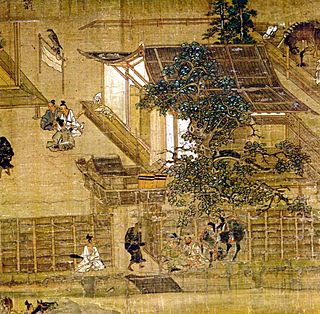Related Research Articles
Kami are the deities, divinities, spirits, phenomena or "holy powers" that are venerated in the Shinto religion. They can be elements of the landscape, forces of nature, or beings and the qualities that these beings express; they can also be the spirits of venerated dead people. Many kami are considered the ancient ancestors of entire clans. Traditionally, great leaders like the Emperor could be or became kami.

In a religious context, sin is a transgression against divine law or a law of God. Each culture has its own interpretation of what it means to commit a sin. While sins are generally considered actions, any thought, word, or act considered immoral, selfish, shameful, harmful, or alienating might be termed "sinful".

A gokenin (御家人) was initially a vassal of the shogunate of the Kamakura and the Muromachi periods. In exchange for protection and the right to become jitō, a gokenin had in times of peace the duty to protect the imperial court and Kamakura. In times of war, he had to fight with his forces under the shōgun’s flag. From the mid-13th century, the fact that gokenin were allowed to become de facto owners of the land they administered, coupled to the custom that all gokenin children could inherit, brought the parcelization of the land and a consequent weakening of the shogunate. The gokenin class ceased to be a significant force during the Muromachi period and was supplanted by the figure of the daimyō. During the successive Edo period, the term finally came to indicate a direct vassal of the shōgun, below an omemie (御目見), meaning that they did not have the right to an audience with the shōgun.
Harae or harai is the general term for ritual purification in Shinto. Harae is one of four essential elements involved in a Shinto ceremony. The purpose is the purification of pollution or sins and uncleanness. These concepts include bad luck and disease as well as guilt in the English sense.
The Japanese word mitama refers to the spirit of a kami or the soul of a dead person. It is composed of two characters, the first of which, mi, is simply an honorific. The second, tama (魂・霊) means "spirit". The character pair 神霊, also read mitama, is used exclusively to refer to a kami's spirit. Significantly, the term mitamashiro is a synonym of shintai, the object which in a Shinto shrine houses the enshrined kami.
Oshō (和尚) is a Buddhist priest ; honorific title of preceptor or high priest. The same kanji are also pronounced kashō as an honorific title of preceptor or high priest in Tendai or Kegon Buddhism and wajō as an honorific title of preceptor or high priest in Shingon, Hossō, Ritsu, or Shin Buddhism.
A Kannushi, also called shinshoku, is a person responsible for the maintenance of a Shinto shrine as well as for leading worship of a given kami. The characters for kannushi are sometimes also read as jinshu with the same meaning.

Gorintō (五輪塔) is a Japanese type of Buddhist pagoda believed to have been first adopted by the Shingon and Tendai sects during the mid Heian period. It is used for memorial or funerary purposes and is therefore common in Buddhist temples and cemeteries. It is also called gorinsotōba or gorinsotoba (五輪卒塔婆) or goringedatsu (五輪解脱), where the term sotoba is a transliteration of the Sanskrit word stupa. The stupa was originally a structure or other sacred building containing a relic of Buddha or of a saint, then it was gradually stylized in various ways and its shape can change quite a bit according to the era and to the country where it is found. Often offertory strips of wood with five subdivisions and covered with elaborate inscriptions also called sotoba can be found at tombs in Japanese cemeteries. The inscriptions contain sūtra and the posthumous name of the dead person. These can be considered stupa variants.

A hōkyōintō (宝篋印塔) is a Japanese pagoda, so called because it originally contained the Karaṇḍamudrā Dhāraṇī Sūtra (宝篋印陀羅尼経). A Chinese variant of the Indian stūpa, it was originally conceived as a cenotaph of the King of Wuyue – Qian Liu.
This is the glossary of Shinto, including major terms on the subject. Words followed by an asterisk (*) are illustrated by an image in one of the photo galleries.

Shichidō garan is a Japanese Buddhist term indicating the seven halls composing the ideal Buddhist temple compound. This compound word is composed of shichidō (七堂), literally meaning "seven halls", and garan (伽藍), meaning "temple". The term is often shortened to just garan. Which seven halls the term refers to varies, and 七堂 may be a misinterpretation of shitsudō (悉堂), meaning "complete temple". In practice, shichidō garan often simply means a large temple with many buildings.
Sin is an important concept in Islamic ethics that Muslims view as being anything that goes against the commands of God in Islam Allah (God) or breaching the laws and norms laid down by religion. Islam teaches that sin is an act and not a state of being. It is believed that God weighs an individual's good deeds against their sins on the Day of Judgement and punishes those individuals whose evil deeds outweigh their good deeds.

In Japanese architecture the term hisashi (廂・庇) has two meanings:
- As more commonly used, the term indicates the eaves of a roof, that is, the part along the edge of a roof projecting beyond the side of the building to provide protection against the weather.
- The term is however also used in a more specialized sense to indicate the area surrounding the moya either completely or on one, two, or three sides.
The Japanese noun hotoke (仏) is a word of Buddhist origin and uncertain etymology. It has several meanings, all but a few directly linked to Buddhism. It can refer to:

Christian theology is the theology of Christian belief and practice. Such study concentrates primarily upon the texts of the Old Testament and of the New Testament, as well as on Christian tradition. Christian theologians use biblical exegesis, rational analysis and argument. Theologians may undertake the study of Christian theology for a variety of reasons, such as in order to:
Kegare is the Japanese term for a state of pollution and defilement, important particularly in Shinto as a religious term. Typical causes of kegare are the contact with any form of death, childbirth, disease, and menstruation, and acts such as rape. In Shinto, kegare is a form of tsumi, which needs to be somehow remedied by the person responsible. This condition can be remedied through purification rites called misogi and harae. Kegare can have an adverse impact not only on the person directly affected, but also to the community they belong to.
Pagodas in Japan are called tō, sometimes buttō or tōba and historically derive from the Chinese pagoda, itself an interpretation of the Indian stupa. Like the stupa, pagodas were originally used as reliquaries but in many cases they ended up losing this function. Pagodas are quintessentially Buddhist and an important component of Japanese Buddhist temple compounds but, because until the Kami and Buddhas Separation Act of 1868, a Shinto shrine was normally also a Buddhist temple and vice versa, they are not rare at shrines either. The famous Itsukushima Shrine, for example, has one.
In Japanese mythology and folklore, Somin Shōrai was a poor man who gave food and shelter to a certain god in the guise of a traveler who was looking for a place to stay. As a reward, the god provided Somin Shōrai's family a means to save themselves from an oncoming pestilence that eventually claimed the lives of those who had turned him away earlier. The story of Somin Shōrai is the basis for the Shinto custom of walking through a large ring of twisted miscanthus reeds during the beginning of summer at many Shinto shrines across Japan. Talismans bearing Somin Shōrai's name are also popularly held to ward off disease and misfortune.
The concept of sin, in the sense of violating a universal moral code, was unknown in Chinese philosophy and folk religion until around the second century CE, when Buddhism arrived from India and religious Daoism originated. While English lexically differentiates theological sin from legal crime, the Chinese language uses one word zui 罪 meaning "crime; guilt; misconduct; sin; fault; blame."
"Tsumi no Keishō " is the forty-eighth single of Japanese recording artist Gackt. It was released on March 22, 2017. The single was used as the ending theme for the anime Trickster. In the song Gackt was seeking to portray the essence of human beings.
References
- 1 2 3 4 5 6 7 8 9 Matsumoto, Shigeru. "Tsumi". Shogakukan Encyclopedia. Yahoo! Japan. Retrieved 16 August 2010.
- 1 2 3 4 Iwanami Kōjien (広辞苑) Japanese dictionary, 6th Edition (2008), DVD version, "Tsumi"
- ↑ Definition from the Iwanami Kōjien Japanese dictionary, 6th Edition (2008), DVD version, "Tsutsumu"